Stamp out the damp!
05 Jun 2014, Prove Your Know How, Technical

Dampness and moisture problems are well-known features of many New Zealand houses. When undertaking renovations, or building new, there are some key ways to knock moisture problems on the head – or stop them from occurring in the first place.
The biggest concern about damp homes relates to their effect on inhabitants’ health: internal moisture makes it harder to keep houses warm and encourages the growth of mould and breeding of dust mites – all of which can cause or worsen asthma, bronchitis and other breathing disorders.
What to watch for when building new
Although building design (orientation, insulation, ventilation) can make a big difference to whether houses will be damp, the way you build the house also has a huge impact. New houses usually have high internal moisture levels for up to two years after construction. Moisture comes from concrete, masonry, timber, plaster and paint – all of which take time to dry out.
There are a number of things you can do to reduce the amount of construction moisture, and therefore the drying time:
- Building during summer (particularly those early critical stages before the house is enclosed) can make a huge difference – concrete slabs and timber that has been rained on take a lot longer to dry out, even once enclosed.
- Ensure materials are dry before enclosing the house – materials dry much faster in open air. Timber framing with the 20% moisture allowed by the Building Code will still contribute around 200 litres of water into the average house. Regard the Building Code as a minimum and let timber dry out as much as possible.
- Take particular care with concrete – 1m3 of concrete has around 95 litres of water, which needs to evaporate out even once it’s been cured. There’s a lot of water in a concrete slab. Wet concrete should have the minimum amount of water added to enable it to be workable – check the slump of concrete which arrives for your slab pour and don’t accept concrete which is too wet.
- Ensure there is a ground moisture barrier under both concrete slabs and suspended floors – about 45 litres of water per day comes out of the ground under a 93m2 house and 90 litres per day under a 186m2 house.
Solving moisture problems in existing houses
Many existing homes have dampness and moisture problems caused by a combination of factors, such as rising damp, lack of ventilation, insufficient insulation and leaks. Renovations represent a real opportunity to solve these problems, so make sure your client thinks not just about the cosmetic factor, but also gets a house that is drier and healthier to live in.
The table below outlines some common problems contributing to moisture, as well as solutions for your clients.
Getting advice
Sometimes it’s hard to work out the underlying cause of dampness in a house. If it’s not obvious, it’s a good idea to get an accredited Home Performance Advisor or, if your council has one, an Eco Design Advisor to come and take a look at the house. They can talk to you and your client about potential solutions and the most effective way to make the house dry and healthy.
About Beacon Pathway
Beacon Pathway is an Incorporated Society committed to transforming New Zealand’s homes and neighbourhoods through research and demonstration projects that show how to make homes more resource efficient, healthier to live in, adaptable, resilient and affordable. For further information about Beacon Pathway visit www.beaconpathway.co.nz
Register to earn LBP Points Sign in






